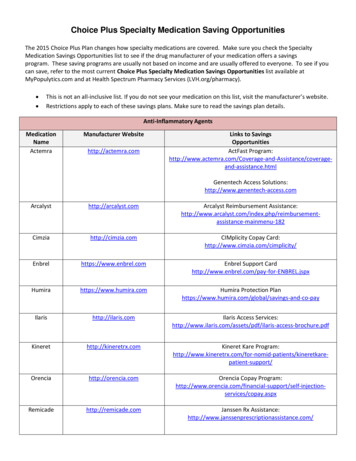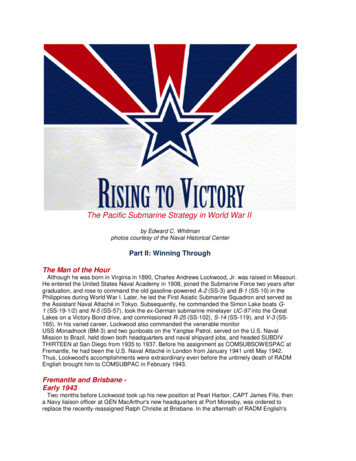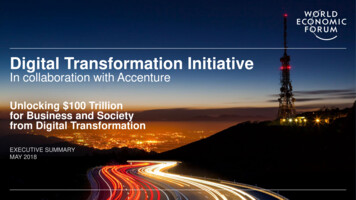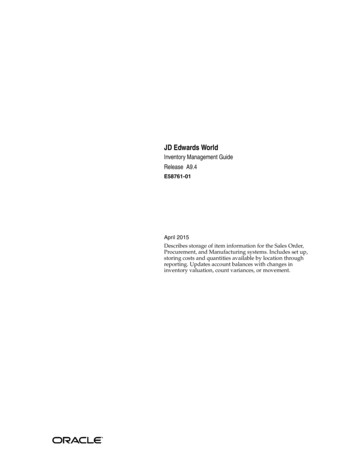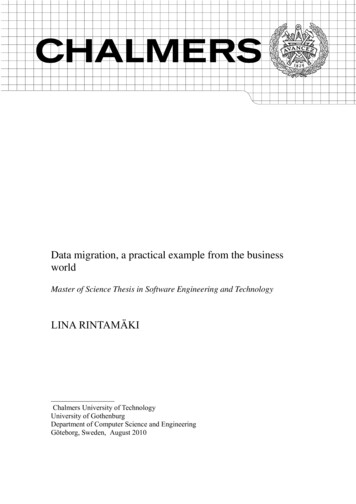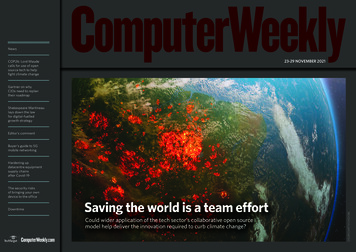
Transcription
HomeHomeNews23-29 NOVEMBER 2021COP26: Lord Maudecalls for use of opensource tech to helpfight climate changeGartner on whyCIOs need to replantheir roadmapShakespeare Martineaulays down the lawfor digital-fuelledgrowth strategyEditor’s commentBuyer’s guide to 5Gmobile networkingHardening updatacentre equipmentsupply chainsafter Covid-19DowntimeSaving the world is a team effortCould wider application of the tech sector’s collaborative open sourcemodel help deliver the innovation required to curb climate change?computerweekly.com23-29 November 2021 1OSORIOARTIST/ADOBEThe security risksof bringing your owndevice to the office
NEWS IN BRIEFNewsCOP26: Lord Maudecalls for use of opensource tech to helpfight climate changeGartner on whyCIOs need to replantheir roadmapShakespeare Martineaulays down the lawfor digital-fuelledgrowth strategyEditor’s commentBuyer’s guide to 5Gmobile networkingHardening updatacentre equipmentsupply chainsafter Covid-19The security risksof bringing your owndevice to the officeDowntimeHMRC should boost data analyticscapability, says NAO reportGovernment proposes new rulesfor digital supply chain securityHM Revenue and Customs (HMRC)should focus on developing its dataand analytics capability to better manage tax debt through the pandemic,according to a report published bythe National Audit Office (NAO).The report focuses on the wider economic impact of the pandemic, andthe tax department’s decision to suspend most debt collection, which hasled to large increases in the amount oftax owed to HMRC.The UK government has unveiledplans to boost the cyber security ofthe country’s digital supply chainswith a series of measures that couldinclude mandating IT service providers to adhere to the National CyberSecurity Centre’s Cyber AssessmentFramework. The proposals follow aDepartment for Digital, Culture, Mediaand Sport consultation on the issue ofdigital supply chains and third-party ITservices, launched in May.Post Office agrees to shareprivileged legal informationONS data points to rise in UKtech employment for womenThe Post Office has agreed to waiveprofessional privilege for documentsrequired for the public inquiry intothe Horizon computer scandal. Thelegal advice given to the Post Officeduring its wrongful prosecutions ofsubpostmasters for financial crimeswill be available to the public inquiryinto the scandal. Inquiry chair WynWilliams initially made the request ata hearing earlier this month.Employment data from the Office forNational Statistics (ONS) has revealedthat female professionals representedmost of the professionals placed inthe jobs market between July andSeptember. According to the report,some 58,000 jobs were created inthe information and communicationcategory during the period, of which41,000 (71%) of the professionalsplaced were women.❯Catch up with the latest IT news onlineWOJCIECH WRZESIEN/ADOBEHomeRoyal Navy gets 100melectronic warfare boostThe Ministry of Defence has awardeda 100m contract through DefenceEquipment and Support to deliver electronic warfare to the Royal Navy. Under theBabcock-led partnership with Elbit Systemsand QinetiQ, the electronic warfare systems will aim to improve the simultaneous detection and identification of radarsignals over a greater frequency range thancurrent capabilities. The technology is saidto enable faster decision-making.computerweekly.com23-29 November 2021 2
NEWS IN BRIEFHomeCOP26: Lord Maudecalls for use of opensource tech to helpfight climate changeGartner on whyCIOs need to replantheir roadmapShakespeare Martineaulays down the lawfor digital-fuelledgrowth strategyEditor’s commentBuyer’s guide to 5Gmobile networkingHardening updatacentre equipmentsupply chainsafter Covid-19The security risksof bringing your owndevice to the officeDowntimeNvidia/Arm: Competitions andMarkets Authority drills deeperCyber security startupsline up on Cyber RunwayDigital secretary Nadine Dorries hasasked the Competition and MarketsAuthority to carry out a Phase 2investigation into Nvidia’s takeoverof Arm on national security andcompetition grounds.Cyber startup specialist Plexal hasannounced that a total of 108 UKsecurity startups are to join its accelerator programme, designed toaddress some of the most pressingsecurity challenges facing the UK.General Motors restructures IT todevelop 25bn software businessAverage size of hyperscaledatacentres on the riseGeneral Motors has restructured its ITfunction to support its goal of growingsoftware-enabled services revenue to 25bn a year by 2030. The IT role hasbeen split into two, one focusing onback-office IT, the other a digital business software function.The average size of a hyperscale datacentre is on the rise, with data suggesting the capacity of these supersizeserver farms has doubled in less thanfour years. Synergy has begun trackingthe compute capacity contained inthese hyperscale datacentres.National Infrastructure Commissionpinpoints strategic gapsVodafone announces solidfirst half-year resultsThe UK has made significant progresson its gigabit broadband roll-out andthere is now wide reach of 4G mobileconnectivity, but there is further togo to avoid any places being leftbehind, the National InfrastructureCommission has warned.Vodafone has released first half-yearresults showing solid advances inrevenue, EBITDA and cash inflow,but with profits pegged back. Forthe six months ended 30 September,Vodafone announced total revenuesof 22.49bn. n❯Catch up with the latest IT news onlineOne-fifth of cyberincidents supportedby NCSC Covid-linkedAn attempted ransomware attackagainst University of Oxford researchersworking on Covid-19 vaccine researchwas among hundreds of incidentsthwarted with help from the NationalCyber Security Centre (NCSC).THAUT IMAGES/ADOBENews❯ Amazon to stop accepting Visa credit cards in UK.❯ Sky ECC provided Canadian police with cryptophones.❯ NHS Digital announces sustainability pledge.❯ Openreach in consultation over transition to fibre.computerweekly.com23-29 November 2021 3
ANALYSISHomeCOP26: Lord Maudecalls for use of opensource tech to helpfight climate changeCOP26: Lord Maude calls for use of opensource tech to help fight climate changeGartner on whyCIOs need to replantheir roadmapPublic and private sector organisations need to pool their resources and collaborate to address the climate crisisby using open source technologies, urged Lord Maude during OpenUK’s COP26 event. Caroline Donnelly reportsNewsShakespeare Martineaulays down the lawfor digital-fuelledgrowth strategyEditor’s commentBuyer’s guide to 5Gmobile networkingHardening updatacentre equipmentsupply chainsafter Covid-19The security risksof bringing your owndevice to the officeDowntimeBusinesses and governments across the world could accelerate their technological efforts to arrest the pace of climate change by adopting open source-like ways of working, says ex-Cabinet Office minister Lord Maude of Horsham.Speaking to Computer Weekly at OpenUK’s COP26 fringe eventin Glasgow, Maude said taking an open, collaborative approach totackling the urgent and complex issue of climate change wouldgarner faster results compared with invested parties all trying todo their own thing.By working together, organisations across the private and publicsector could save huge amounts of time, energy and resources,and “unleash the innovation” needed to address the climate crisis,he said. “The open approach to technology makes its own contribution to energy conservation because you’re not constantlyreinventing the wheel.“The contribution that open can make through recycling ideas,encouraging collaboration, removing duplication of effort andreplication – all of that can, in itself, be valuable.”As defined by Maude during his keynote speech at the OpenUKTechnology for Sustainability Day, taking an open approach totechnology means companies making their software and hardware available to others to use and develop further over time.“This community collaborative approach builds the communityfaster, encourages sharing and collaboration, and delivers highquality, rather than everyone trying to do their own thing,” he said.“Today, open source has led to the creation of some of the world’smost valuable technology companies. These are indications thatopen is now something of value.”Much of Maude’s time at the Cabinet Office involved workingon initiatives designed to help departments streamline their processes, become more efficient and transform the way they deliverpublic services.Some of this work was delivered through the work of the coalition government’s Efficiency and Reform Group, which was operational between 2010 and 2014 and is credited with helping to cutthe government’s operating costs by 52bn.computerweekly.com23-29 November 2021 4
ANALYSISShakespeare Martineaulays down the lawfor digital-fuelledgrowth strategy“We [the Cabinet Office] had inherited government IT that wasthe most expensive in the world, and I don’t want to boast, butalso notorious for car-crash failures,” Maude told attendees. “Wewere ensnared in a spider’s web of huge, multi-year, impenetrable IT contracts with built-in dependence on proprietary products and exclusive services provided by a pretty narrow group ofmulti-national vendors.”Maude also had a hand in creating the Government DigitalService (GDS) in 2011, which sought to revamp the way government services are provided to citizens by moving to a digital-bydefault delivery model, underpinned wherever possible by opensource technologies.Editor’s commentCreation of Gov.uk websiteNewsCOP26: Lord Maudecalls for use of opensource tech to helpfight climate changeGartner on whyCIOs need to replantheir roadmapBuyer’s guide to 5Gmobile networkingHardening updatacentre equipmentsupply chainsafter Covid-19The security risksof bringing your owndevice to the officeDowntimeOne of GDS’s landmark projects was the creation of the Gov.ukwebsite, which provides a single, centralised hub where citizenscan find information about government services.As detailed in the keynote, the creation of Gov.uk paved the wayfor nearly 2,000 government websites to be removed from theweb, making it easier for citizens to find the information they need.“We onboarded the whole of government onto a single website,built rigorously around the needs of the user,” said Maude.“Built largely in-house with open source code and code that hasbeen used by numerous other governments, each one – of course– developing and enhancing the code for the benefit of themselves, but also for all of us.“We broke open this closed system. We reformed how we procured citizen IT and unleashed a vibrant ecosystem.”PUNIT PARANJPE/GETTYHomeLord Maude: “Thereis a real excitementaround innovation,technologicalinnovation and findingnew ways to addressclimate change”computerweekly.com23-29 November 2021 5
ANALYSISHomeNewsCOP26: Lord Maudecalls for use of opensource tech to helpfight climate changeGartner on whyCIOs need to replantheir roadmapShakespeare Martineaulays down the lawfor digital-fuelledgrowth strategyEditor’s commentBuyer’s guide to 5Gmobile networkingHardening updatacentre equipmentsupply chainsafter Covid-19The security risksof bringing your owndevice to the officeDowntimeMaude also touched on another initiative embarked on duringhis time in government that was designed to eradicate the duplication of IT resources at a datacentre level through the creation ofthe Cabinet Office’s private sector joint venture, Crown Hosting.“One of the worst mischiefs we discovered lay in the opaqueworld of the government’s datacentre estate,” said Maude. “Noone knew where they were, how many there were, their locationand who – if anyone – controlled them.“There was no coordination and hideously limited interoperability. There was absurd over-provisioning. Every department andagency – and often every part of every department and agency –had provided its own business continuity capacity. Unsurprisingly,in some parts of government, it emerged there was as much as97% redundancy.”Centralised hosting environmentTo address this, Crown Hosting was launched in March 2015.The venture was intended to help government departmentsshutter their datacentres by providing them with a centralisedhosting environment where all of their legacy, on-premise workloads could reside.“It was much more energy-efficient, much more financially efficient and it led to the eradication of vast swathes of redundancy,”said Maude. “So using this same approach – collaboration andcommunication, sharing, and recycling and reusing technology –is needed today around climate change.”Maude’s comments on this point came ahead of the launchat OpenUK’s event of its carbon-negative datacentre blueprint,❯OpenUK puts forward plan to reduce the environmental impact of datacentres.Patchwork Kilt, which aims to encourage datacentre operators torecycle and refurbish their under-utilised datacentre equipment.The blueprint is still a work in progress, and the idea is that theopen source community will throw their weight behind the initiative and contribute their ideas about what can be done to makedatacentres more energy efficient and environmentally friendly.On a related point, during his interview with Computer Weekly,Maude said one of the defining characteristics of COP26 was thewillingness of private sector organisations to get involved withdoing what needs to be done from a technology perspective toaddress climate change.Time is running outOne reason for that, he said, is because time is running out tosave the planet, which is why it is so important to pick up thepace of developing the technologies needed to curb greenhousegas emissions and hasten the renewable energy transition.“What’s marking this COP out against previous ones is how theprivate sector has shown up, and how there is a real excitementaround innovation, technological innovation and finding new waysto address climate change,” he told Computer Weekly.“We’ve seen how the cost of renewables is plummeting compared with carbon, we’ve seen how new technologies are emerging rapidly around electric vehicles, around carbon capture andthe open approach to allowing and encouraging these technologies to be more widely available. The greater the extent to whichthat can permeate through climate change, technological changeand innovation, the quicker the results will come through.” ncomputerweekly.com23-29 November 2021 6
ANALYSISHomeCOP26: Lord Maudecalls for use of opensource tech to helpfight climate changeGartner on whyCIOs need to replantheir roadmapShakespeare Martineaulays down the lawfor digital-fuelledgrowth strategyEditor’s commentBuyer’s guide to 5Gmobile networkingHardening updatacentre equipmentsupply chainsafter Covid-19The security risksof bringing your owndevice to the officeDowntimeGartner: CIOs should replan their roadmapThe IT function has always been about gaining more efficiency by automating processes, but greaterefficiency doesn’t lead to a step change in business outcomes – and that is what’s needed. Cliff Saran reportsIT leaders are being urged to consider how they take their roleforward, as organisations develop business strategies that relyheavily on digital technologies. Gartner analysts say technology could help CIOs gain freedom from historical insights, legacybusiness practices and bias.Speaking during the opening keynote at the virtual GartnerSymposium conference, Daryl Plummer, distinguished researchvice-president and Gartner fellow, said: “CIOs need to reconsider how they think about value, and how they get to that value.They need a more expansive view of the role technology plays indoing so, and they must be bold to reach beyond the ‘where’ todiscover freedom.”The biggest change moving forward will be how IT is financed– not necessarily how much. “IT is transitioning from supporting the business to being the business, which means spendingon technology shifts from a cost of operations (selling, generaland administrative) to a cost of revenue, or possibly cost of goodssold,” said John Lovelock, distinguished research vice-president atGartner. “CIOs have a balancing act to perform – saving cash andexpanding revenue.”ROMAN MOTIZOV/ADOBENewsGartner says the biggestchange moving forward willbe how IT is financed – notnecessarily how muchcomputerweekly.com23-29 November 2021 7
ANALYSISHomeNewsCOP26: Lord Maudecalls for use of opensource tech to helpfight climate changeGartner on whyCIOs need to replantheir roadmapShakespeare Martineaulays down the lawfor digital-fuelledgrowth strategyEditor’s commentBuyer’s guide to 5Gmobile networkingHardening updatacentre equipmentsupply chainsafter Covid-19The security risksof bringing your owndevice to the officeDowntimeLovelock said 2022 would continue the evolution of IT, as businesses adapt to a post-pandemic reality: “People have changed,but we are still social beings.”This means people are unlikely to return to pre-Covid workingpatterns, where the majority of office workers commuted to anoffice daily. Whatever hybrid working becomes, Lovelock saidthe way content is shared and how collaboration takes place willbe fundamental to the way the workplace evolves. For instance,older technologies such as digital whiteboards could be used toencourage collaboration.However, he pointed out that there was also a need for asynchronous forms of collaboration, to enable people who work different hours or are located in different time zones to participatein online meetings.Changing spending patternsAccording to Gartner’s latest spending forecast, enterprise software spending in Europe, the Middle East and Africa (EMEA)is estimated to have the highest growth in 2022, driven by therise in cloud spending. Spending on software is set to growby 10%, ahead of IT services, which Gartner has forecast willgrow by 8.2%.Gartner estimated that enterprise cloud spending would represent 12.5% of total enterprise IT spending in 2022. Infrastructureas a service (IaaS) and desktop as a service (DaaS) are expectedto be the two segments where EMEA organisations will increasetheir spending the most in 2022, achieving 32.3% and 31.1%growth, respectively.❯Gartner: Pandemic pushed IT to top of the business agenda and integration is key.Looking at IT buying habits, Lovelock said it was “seeing a fundamental shift”. More organisations are moving from buying ITproducts to a service model. “Licence software sales are on aInstead of looking at efficiencysavings, IT leaders should thinkabout how IT could enable thebusiness to earn more moneydecline and datacentre growth is flat for the next few years. Theownership model is going away,” he added.While IT leaders have demonstrated their effectiveness atenabling business operations to continue during the pandemic,Lovelock warned that most companies would fall behind in termsof digital transformation. “They won’t be able to digitally transform,” he said.Hybrid approachAny partial digital transformation leads to a hybrid approach,which, according to Lovelock, would widen the gap from similarorganisations that have fully embraced digitisation. “Don’t doold processes with new technology,” he said.Instead of looking at efficiency savings, Lovelock said IT leaders should think about how IT could enable the business to earncomputerweekly.com23-29 November 2021 8
OLIVIER LE MOAL/ADOBEHomeNewsCOP26: Lord Maudecalls for use of opensource tech to helpfight climate changeGartner on whyCIOs need to replantheir roadmapShakespeare Martineaulays down the lawfor digital-fuelledgrowth strategyBusiness expectations of IThave changed from providinga stable environment torevenue generationEditor’s commentBuyer’s guide to 5Gmobile networkingHardening updatacentre equipmentsupply chainsafter Covid-19The security risksof bringing your owndevice to the officeDowntimemore money, instead of saving a dollar here and there throughefficiency gains. “If you can earn the business a dollar, everything changes,” he said.From an IT management perspective, larger organisations withsubstantial IT practices can be held back by the way they chargefor internal services. This is known as chargeback. “This relies onolder accounting practices,” said Lovelock. “Chargeback is a reason why IT doesn’t move as fast as it can.”In Lovelock’s experience, companies are making generationaldecisions about technology. “Some of the projects that are happening now are through partnerships with technology providersthat work with a client to develop a new business model,” hesaid. This changes IT’s relationship with the business. “The CIO’scareer has been about providing a stable environment. Now thebusiness wants IT to generate revenue,” added Lovelock.His advice is similar to that given in a recent McKinsey article,which looked at how CIOs themselves need to change to helpdrive business change.“CIOs need to make the leap from tech leader to business driver,and the actions they take in the next 12 months will largely determine whether their business can meet its aspirations,” said AmerBaig, a senior partner at McKinsey. ncomputerweekly.com23-29 November 2021 9
INTERVIEWHomeCOP26: Lord Maudecalls for use of opensource tech to helpfight climate changeShakespeare Martineau lays down thelaw for digital-fuelled growth strategyGartner on whyCIOs need to replantheir roadmapLaw firm Shakespeare Martineau is increasingly digitising its business and readying its infrastructurefor future merger and acquisition activity, as Dal Virdi, the company’s IT director, tells Mark SamuelsNewsShakespeare Martineaulays down the lawfor digital-fuelledgrowth strategyEditor’s commentBuyer’s guide to 5Gmobile networkingHardening updatacentre equipmentsupply chainsafter Covid-19The security risksof bringing your owndevice to the officeDowntimeDal Virdi, IT director at law firm Shakespeare Martineau,took an unconventional route into technology management. While some of his contemporaries spent manyyears striving to get into the CIO role, Virdi became technologychief at a point in his career when it seemed more likely he wasgoing to leave the profession.Virdi joined Shakespeare Martineau in March 2018 after leadingstrategy, architecture and engagement at another law firm, IrwinMitchell. At the time, he was considering retirement, and wasn’tnecessarily looking for another senior role. But then the opportunity at Shakespeare Martineau came up and everything changed.“I guess I wasn’t prepared for taking it easy,” he says. “The role,initially, was in business engagement. But the interview for thatposition was stopped after about 10 minutes and they recognisedthat I was perhaps over-skilled for that engagement role. Theyasked me if I’d consider a different role within the firm.”Shakespeare Martineau’s leadership team didn’t have a suitablevacancy at the time, but they felt Virdi possessed a set of skillsDal Virdi,ShakespeareMartineau: “Iguess I wasn’tprepared fortaking it easy”computerweekly.com23-29 November 2021 10
INTERVIEWHomeNewsCOP26: Lord Maudecalls for use of opensource tech to helpfight climate changeGartner on whyCIOs need to replantheir roadmapShakespeare Martineaulays down the lawfor digital-fuelledgrowth strategyEditor’s commentBuyer’s guide to 5Gmobile networkingHardening updatacentre equipmentsupply chainsafter Covid-19The security risksof bringing your owndevice to the officeDowntimethat were right for the organisation. He eventually joined in theposition of strategic solutions manager. It was an opportunity tosee what Virdi offered, and vice versa.Within three months, the board were talking about Virdi becoming IT director – and by September 2018, he was leading technology for the firm. Three years on and he’s still enjoying the unexpected test of being a CIO.“We’ve gone from anenvironment that used to havesignificant outages to a servicethat’s gone at least 200 dayswithout a significant outage”Dal Virdi, Shakespeare Martineau“Every day brings new challenges, so I do absolutely enjoy it,” hesays. “I think the way the firm has grown, its ambitions, and theway that it tries to look after its people and encourages them todo more for the group, mean that it’s a great place to work.”Shakespeare Martineau is a leading UK law firm, with morethan 850 legal experts in offices across the country. The businesshas an ambitious growth strategy to more than double its sizeby 2025. The past decade has seen considerable growth for thefirm, which has expanded through a number of acquisitions. Thesize of the organisation doubled overnight when Shakespearesmerged with SGH Martineau in 2015. However, the IT team atthe time had not necessarily recognised the impact that this process would have on their systems and data. Virdi saw how hisexperience could help.“The opportunity was around the fact that their IT landscapewas quite backward, given the number of acquisitions they’d takenon and how they’d grown as a business,” he says. “They had a veryfunctional IT team, but they didn’t necessarily know what otheropportunities existed to help develop the firm with technology.“I could see what was ahead of me in making a difference for thefirm, and being able to elevate them to where they needed to bein order to be more competitive within the market, and to lay thefoundations for what they were aspiring to be moving forward.”Strong family feelDuring his three years as technology chief, Virdi has brought arange of people into the organisation, including IT professionalshe had worked with in his previous roles. He says ShakespeareMartineau retained a strong family feel, despite its growth, andthe board was keen to make the changes to IT that would helpthe firm move in the right direction.“Everybody was supporting each other, everybody recognisedthe need to do things differently and everybody wanted to improvein lots of different ways,” he says. “That family feel and supportiveculture makes a real difference and I’ve loved my time at the firm.”As IT director, Virdi’s primary responsibilities concern the development and management of digital strategy, and technologicalcomputerweekly.com23-29 November 2021 11
INTERVIEWHomeNewsCOP26: Lord Maudecalls for use of opensource tech to helpfight climate changeGartner on whyCIOs need to replantheir roadmapShakespeare Martineaulays down the lawfor digital-fuelledgrowth strategyEditor’s commentBuyer’s guide to 5Gmobile networkingHardening updatacentre equipmentsupply chainsafter Covid-19The security risksof bringing your owndevice to the officeDowntimeoversight and governance for all technical solutions across thefirm, including IT-related merger and acquisition activities.He has introduced strong disciplines within the IT organisationin recent years, such as a focus on change management. Virdi hasbeen able to embed a fresh cultural approach that means the ITteam now considers how its work will have a greater impact onbusiness operations, particularly in terms of generating value.“One of the key streams that we are most proud of is that we’vegone from an environment that used to have quite significant outages to a service that’s gone at least 200 days without a significant outage, and I think the last outage that we actually had wasdown to somebody accidentally tripping over a cable that wentinto one of our Exchange servers,” he says.“That was about getting everybody to understand what weneeded to do differently,” he says. “Don’t get me wrong, we’venot exposed all of the skeletons – we are still finding things thatpeople didn’t know about. But at least we’re much better placedto have that level of agility, with the knowledge that we have on allthe peripheral systems.”“We’ve not exposed all of theskeletons – we still find thingsthat people didn’t know about”Dal Virdi, Shakespeare MartineauStrengthen IT securityVirdi says the IT team has continued to work hard to strengthenthe IT security position of the firm. For example, the teamworked with consultant PwC to conduct a full maturity assessment of technology across the organisation. That process helpedto show the board how new investment in IT security would helpimprove the firm’s position, says Virdi. “We’ve had the supportover the last couple of years to build a cyber security awarenessprogramme and to create continuous improvement,” he adds.The final big area of work during the past three years involvesaddressing system complexity. Virdi says Shakespeare Martineau’sacquisitions created a fragmented landscape of legacy systems,with limited support and documentation. The IT team encouraged the business to start addressing this issue.❯Johnson Matthey CIO Paul Coby is working to create an agile IT department.Virdi says one of his most critical decisions was to overhaulthe firm’s IT infrastructure and introduce a Nutanix private cloudplatform. He says the hyper-converged infrastructure offers thecapabilities of a cloud-first strategy combined with the security,performance and compliance needed from an on-premise privatecloud solution. “We’ve emphasised the fact that our internal andexternal clients are absolutely key. We always need to considerthe services we’re delivering, internally and externally – and weneed to keep the firm on its feet. Without the firm operating properly, there’s going to be a big impact on revenues and reputation.”Virdi says overcoming the challenges associated with Covid-19has provided further evidence of the benefits of technology. TheIT team was able to deploy laptops with a full VPN and managedcomputerweekly.com23-29 November 2021 12
INTERVIEWHomeNewsCOP26: Lord Maudecalls for use of opensource tech to helpfight climate changeGartner on whyCIOs need to replantheir roadmapShakespeare Martineaulays down the lawfor digital-fuelledgrowth strategyEditor’s commentBuyer’s guide to 5Gmobile networkingHardening updatacentre equipmentsupply chainsafter Covid-19The security risksof bringing your owndevice to the officeDowntimedesktop capability. This meant remote employees could
develop 25bn software business General Motors has restructured its IT function to support its goal of growing software-enabled services revenue to 25bn a year by 2030. The IT role has been split into two, one focusing on back-office IT, the other a digital busi-ness software function. National Infrastructure Commission pinpoints strategic gaps
